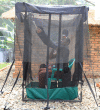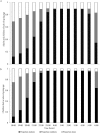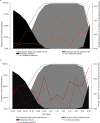Linking human behaviours and malaria vector biting risk in south-eastern Tanzania
- PMID: 31158255
- PMCID: PMC6546273
- DOI: 10.1371/journal.pone.0217414
Linking human behaviours and malaria vector biting risk in south-eastern Tanzania
Abstract
To accelerate malaria elimination in areas where core interventions such as insecticide-treated nets (ITNs) are already widely used, it is crucial to consider additional factors associated with persistent transmission. Qualitative data on human behaviours and perceptions regarding malaria risk was triangulated with quantitative data on Anopheles mosquito bites occurring indoors and outdoors in south-eastern Tanzania communities where ITNS are already used but lower level malaria transmission persists. Each night (18:00h-07:00h), trained residents recorded human activities indoors, in peri-domestic outdoor areas, and in communal gatherings. Host-seeking mosquitoes were repeatedly collected indoors and outdoors hourly, using miniaturized exposure-free double net traps (DN-Mini) occupied by volunteers. In-depth interviews were conducted with household representatives to explore perceptions on persistent malaria and its control. Higher proportions of people stayed outdoors than indoors in early-evening and early-morning hours, resulting in higher exposures outdoors than indoors during these times. However, exposure during late-night hours (22:00h-05:00h) occurred mostly indoors. Some of the popular activities that kept people outdoors included cooking, eating, relaxing and playing. All households had at least one bed net, and 83.9% of people had access to ITNs. Average ITN use was 96.3%, preventing most indoor exposure. Participants recorgnized the importance of ITNs but also noted that the nets were not perfect. No complementary interventions were reported being used widely. Most people believed transmission happens after midnight. We conclude that insecticide-treated nets, where properly used, can still prevent most indoor exposures, but significant risk continues unabated before bedtime, outdoors and at communal gatherings. Such exposure is greatest for rural and low-income households. There is therefore an urgent need for complementary interventions, particularly those targeting outdoor-biting and are applicable for all people including the marginalised populations such as migratory farmers and fishermen. Besides, the differences in community understanding of ongoing transmission, and feedback on imperfections of ITNs should be considered when updating malaria-related communication and interventions.
Conflict of interest statement
The authors have declared that no competing interests exist.
Figures







References
-
- National Malaria control Program, Ifakara Health Institute, World Heatlh Organization. An epidemiological profile of malaria and its control in mainland Tanzania. Roll Back Malaria and Department for International Development-UK. 2013.
-
- Tanzania Ministry of Health, Ministry of Health Zanzibar, (NBS) NB of S. Tanzania Malaria Indicator Survey (TMIS): Key Indicators 2017. Dodoma; 2018.
Publication types
MeSH terms
Grants and funding
LinkOut - more resources
Full Text Sources
Medical

